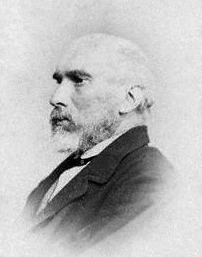William Stirling-Maxwell
Sir William Stirling-Maxwell, 9th Baronet (born March 8, 1818 in Kirkintilloch , † January 15, 1878 in Venice ) was a Scottish nobleman , historian , art historian and politician . His focus was on the study of Spanish art, and he was one of the first art historians to devote himself to the subject in detail. Stirling-Maxwell was the first art historian to use photographic reproductions in a book publication.
Life
Born William Stirling , he was the son of Archibald Stirling (1769–1847), Esquire of Keir and Cadder , and Elizabeth Maxwell (1793–1822), daughter of MP Sir John Maxwell, 7th Baronet (1768–1844), and thus came from old Scottish families. His school career began at the Pilton Rectory in Northamptonshire and the Cossington Rectory in Leicestershire . He then attended Trinity College , Cambridge . He graduated there in 1839. He then traveled through Germany, Switzerland, France and Italy.
In 1841 Stirling applied for Perthshire's seat in the House of Commons , but was unsuccessful. Instead, he went traveling again, this time going to Spain and the Middle East. He published his experiences in the Orient in a travel report in 1846. In 1843 he made his Master of Arts at Cambridge. It was at this time that he decided to write about Spanish art history. He made further trips to study works of art in Spanish and British collections. In 1848 he published his annals of Spanish artists . In it he arranged the artists in his work chronologically according to the reigns of the kings and tried to understand them comprehensively from their context and to understand Diego Rodríguez de Silva y Velázquez not just as an artistic genius. The book was received positively in Great Britain, while the German Carl Justi criticized that he had neglected the artistic techniques in his book. In 1852 he published his most successful book, The Cloister Life of the Emperor Charles the Fifth , which sold very well in Great Britain and which was also published in translations in Germany, Spain and the Netherlands. In 1855 Velazquez and his Works appeared , which was based on the revised artist annal and to which an appendix with prints of his works was attached. Hilary Macartney judged this work as setting the standard, and shortly afterwards it was surpassed by Justis Velazquez's biography. This book was also published in Spanish, German and French. The French edition contained a catalog of the artist's works written by Théophile Thoré . Between 1857 and 1859 Stirling worked on the translation of the annals into Spanish, but it was never published. He published a fourth annals volume with the small edition of only 25 copies, which contained photographs developed by William Fox Talbot and was thus the first art historical work with such reproductions.
After his father died in 1847, he inherited from Heir and Cawder. He started collecting books. His collection of emblem books is now in the University of Glasgow Library . In addition, he also collected works of art, especially paintings and prints from Spain. These included the Spanish Gallery of Louis-Philippe I and the collection of Frank Hall Standish (1799–1840), as well as paintings by El Greco and prints by Francisco de Goya . Because of his interest in photographic reproduction, he published several facsimile editions.
William Stirling was elected Member of Parliament for Perthshire in 1852 and held this position until the end of his life, with a break between 1868 and 1874. In Parliament he was a member of the Art Committee from 1853. He later became a board member of the National Gallery , National Portray Gallery and the British Museum . Since 1849 he was a member ( Fellow ) of the Royal Society of Edinburgh .
In 1863 he was promoted to Knight Bachelor . When his maternal uncle, Sir John Maxwell, 8th Baronet, died childless on June 6, 1865, William Stirling inherited him. He added his family name to Stirling-Maxwell , inherited the title of 9th Maxwell Baronet , of Pollok in the County of Renfrew, and moved to the Pollok Castle estate near Glasgow . In the same year he married Anna Maria Leslie-Melville, who died in a fire in Keir House in 1874. In 1877 he married his second wife, Caroline Elizabeth Sarah Norton , who died that same year. At the beginning of 1878 William Stirling-Maxwell fell ill with a fever in Venice and died. He was buried in the Keir Crypt near Dunblane . His collection and land were sold to his grandson.
From his first marriage he left two sons, Sir John Stirling-Maxwell, 10th Baronet of Pollok (1866-1956) and Brigadier-General Archibald Stirling, of Keir and Cawdor (1867-1931). The founder of the Special Air Service , David Stirling , was his grandson.
Web links
- Information on William Stirling-Maxwell at dictionaryofarthistorians.org
- The Stirling Maxwell Research Project at the University of Glasgow
Individual evidence
- ^ Hilary Macartney, "Maxwell, Sir William Stirling, ninth baronet (1818–1878)", 2004, in: Oxford Dictionary of National Biography. ( Page no longer available , search in web archives ) Info: The link was automatically marked as defective. Please check the link according to the instructions and then remove this notice.
- ^ Fellows Directory. Biographical Index: Former RSE Fellows 1783–2002. (PDF file) Royal Society of Edinburgh, accessed March 20, 2020 .
| personal data | |
|---|---|
| SURNAME | Stirling-Maxwell, William |
| ALTERNATIVE NAMES | Stirling-Maxwell, Sir William, 9th Baronet; Stirling, Sir William; Stirling, William |
| BRIEF DESCRIPTION | Scottish nobleman, politician, member of the House of Commons, art historian, historian and collector |
| DATE OF BIRTH | March 8, 1818 |
| PLACE OF BIRTH | Kirkintilloch |
| DATE OF DEATH | January 15, 1878 |
| Place of death | Venice |
